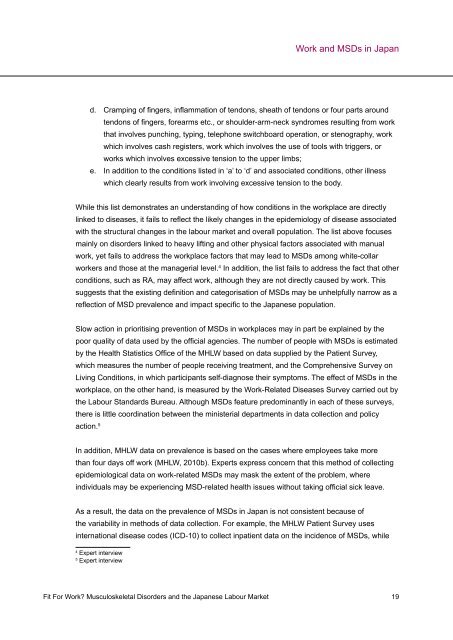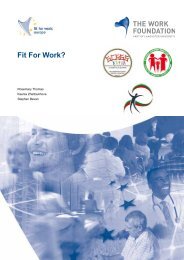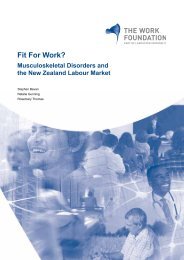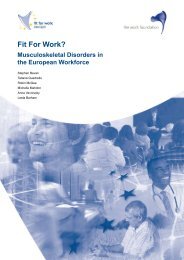English version - Fit for Work Europe
English version - Fit for Work Europe
English version - Fit for Work Europe
You also want an ePaper? Increase the reach of your titles
YUMPU automatically turns print PDFs into web optimized ePapers that Google loves.
d. Cramping of fingers, inflammation of tendons, sheath of tendons or four parts around<br />
tendons of fingers, <strong>for</strong>earms etc., or shoulder-arm-neck syndromes resulting from work<br />
that involves punching, typing, telephone switchboard operation, or stenography, work<br />
which involves cash registers, work which involves the use of tools with triggers, or<br />
works which involves excessive tension to the upper limbs;<br />
e. In addition to the conditions listed in ‘a’ to ‘d’ and associated conditions, other illness<br />
which clearly results from work involving excessive tension to the body.<br />
While this list demonstrates an understanding of how conditions in the workplace are directly<br />
linked to diseases, it fails to reflect the likely changes in the epidemiology of disease associated<br />
with the structural changes in the labour market and overall population. The list above focuses<br />
mainly on disorders linked to heavy lifting and other physical factors associated with manual<br />
work, yet fails to address the workplace factors that may lead to MSDs among white-collar<br />
workers and those at the managerial level. 4 In addition, the list fails to address the fact that other<br />
conditions, such as RA, may affect work, although they are not directly caused by work. This<br />
suggests that the existing definition and categorisation of MSDs may be unhelpfully narrow as a<br />
reflection of MSD prevalence and impact specific to the Japanese population.<br />
Slow action in prioritising prevention of MSDs in workplaces may in part be explained by the<br />
poor quality of data used by the official agencies. The number of people with MSDs is estimated<br />
by the Health Statistics Office of the MHLW based on data supplied by the Patient Survey,<br />
which measures the number of people receiving treatment, and the Comprehensive Survey on<br />
Living Conditions, in which participants self-diagnose their symptoms. The effect of MSDs in the<br />
workplace, on the other hand, is measured by the <strong>Work</strong>-Related Diseases Survey carried out by<br />
the Labour Standards Bureau. Although MSDs feature predominantly in each of these surveys,<br />
there is little coordination between the ministerial departments in data collection and policy<br />
action. 5<br />
In addition, MHLW data on prevalence is based on the cases where employees take more<br />
than four days off work (MHLW, 2010b). Experts express concern that this method of collecting<br />
epidemiological data on work-related MSDs may mask the extent of the problem, where<br />
individuals may be experiencing MSD-related health issues without taking official sick leave.<br />
As a result, the data on the prevalence of MSDs in Japan is not consistent because of<br />
the variability in methods of data collection. For example, the MHLW Patient Survey uses<br />
international disease codes (ICD-10) to collect inpatient data on the incidence of MSDs, while<br />
4 Expert interview<br />
5 Expert interview<br />
<strong>Work</strong> and MSDs in Japan<br />
<strong>Fit</strong> For <strong>Work</strong>? Musculoskeletal Disorders and the Japanese Labour Market 19







